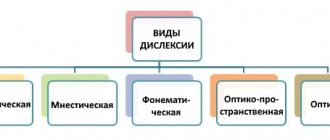General information
Dyslexia, what is it and what kind of disease is it?
Dyslexia (lat. Dyslexia) is a specific partial disorder of the reading process in children/adults and is one of the forms of underdevelopment of written speech, which is manifested by persistent, typical, repeated errors with a normal intellectual level of development, and the absence of any impairments in the auditory/ visual analyzers (Wikipedia).
It manifests itself at the level of a single word/sentence and is expressed by the presence of serious difficulties when reading (recognizing) a printed word or when writing (reproducing) a heard word in the form of letter-by-letter reading, mixing/replacing sounds, agrammatisms, distortion of the structure of the syllables of a word, and impaired comprehension of what has been read. Such children have difficulty mastering the skills of spelling, word pronunciation and written expression of thoughts. Children with dyslexia are unable to achieve levels of reading/writing and spelling skills that are proportional to their intellectual development (mental ability). Dyslexia is often accompanied by such types of disorders as dysgraphia (disorder of the writing process) and dyscalculia (inability to understand/learn arithmetic operations). However, in relation to primary schoolchildren, dyslexia and dysgraphia should not be defined as a disorder, but rather as a difficulty in mastering the process of written speech.
It should be understood that dyslexia is a partial disorder of a skill, while the inability to master a skill/complete loss of an already formed reading skill is referred to as “alexia.” As a rule, alexia is caused by damage to some part of the cerebral cortex due to traumatic brain injury/ stroke . Alexia is rarely an independent manifestation and, as a rule, is combined with impairments in writing (agraphia) and speech (aphasia). It should also be understood that dyslexia, like dysgraphia and dyscalculia, is not a mental illness. Dyslexia, in its pathology, is a neurobiological disorder, which is based on both hereditary and environmental factors damaging brain structures, and the main methods of treatment are speech therapy/pedagogical intervention.
It is known that reading/writing in phylo-ontogenesis refers to new functions of higher mental activity, which are mastered by the individual in the process of special training. In the learning process, the leading role is given to the most recently formed parts of the cerebral cortex, mainly the parieto-occipital-temporal region of the left hemisphere. The implementation of these functions is possible only with close interaction between the auditory/visual/motor analyzers and with sufficient development and the ability to perform complex voluntary actions (coordination of eye and hand movements when writing, movement of the eyeball along lines of text).
The disorder is manifested/diagnosed in childhood, approximately in the 1st-3rd grades of school, when the child exhibits atypical difficulties in mastering the skill of reading, which cannot be explained by other developmental disorders (mental retardation) and inadequate school preparation.
The exact incidence rates of dyslexia have not been established. According to the literature, the prevalence of dyslexia in school-age children with normal intelligence varies between 5–20%. The incidence of dyslexia in boys and girls differs and is 4:1. As studies have shown, about 50% of children with dyslexia after 1–1.5 years of schooling have extremely weak or absent reading skills, which is manifested by ignorance of the alphabet, individual letters, slow syllabic reading, letter-by-letter reading of only very familiar/short words and misunderstanding meaning of what was read.
The results of dyslexia are low performance at school, a decrease in the child’s self-esteem, the formation of a fear (phobia) of reading and, in general, a “phobia of learning,” and disruption of the socialization process. Difficulties in learning to read/write are accompanied by a negative impact on the process of formation of the child’s personality, forming such traits as isolation, uncertainty, anxiety, and if there is an inadequate attitude towards the child’s difficulties on the part of the environment (parents, classmates, teachers), accusing the child of laziness, disobedience, reluctance to learn, and slowness often develop neurotic states (depression, oppositional/aggressive behavior, etc.).
Dyslexia in adults is overwhelmingly due to the lack/ineffectiveness of treatment for dyslexia in children. That is, children do not “outgrow” dyslexia! It has been established that in 70-78% of schoolchildren with a confirmed diagnosis of dyslexia, its manifestations persist into adulthood. Without adequate/timely treatment for dyslexia, it can become long-term and chronic. Less commonly, dyslexia in adults is acquired, as a result of stroke/traumatic brain injury.
Despite various negative manifestations and consequences, dyslexia/dysgraphia does not make a person disabled and does not put an end to the child’s development/his future. Moreover, dyslexics are often gifted in various other areas of life, showing abilities for imaginative, unconventional and creative thinking, as evidenced by the life stories of many outstanding people with manifestations of dyslexia/dysgraphia: Hans Christian Andersen, Walt Disney, Henry Ford, Albert Einstein, Tom Cruise, Marilyn Monroe, Dustin Hoffman and many others.
Complications of dyslexia
Complications of speech disorders are mainly associated with socialization and interaction with society. In childhood, dyslexia leads to poor performance and deterioration of the learning process. Also, this pathology can be the cause of ridicule from peers and, as a result, social alienation. In the future, such factors lead to depressive disorders, inferiority complex and other mental disorders. In adults, dyslexia is a cause of low work ability or inability to perform certain types of work [3].
Pathogenesis
Dyslexia, in accordance with modern concepts, is usually considered as a neurobiological disorder, which is based on dysfunction/underdevelopment of certain areas of the cerebral cortex, mainly the left temporo-parietal region, which is responsible for decoding/sound-letter analysis and the left temporo-occipital region, which is responsible for the process automated recognition of readable words. That is, in individuals with dyslexia, while reading, information is processed in other areas of the brain through alternative adaptive mechanisms.
There are several mechanisms in the formation of dyslexia:
- Impairments of operational-phonological memory - the ability to retain in memory for a short period of time read letters, sounds and syllables (speech segments), as well as their meaning.
- Violation of serial reading (difficulty in remembering a series of characters, their meanings and concepts in general, that is, difficulty in perceiving a whole syllable).
- Insufficient vocabulary, which hinders the adequate development of reading skills.
- Weak ability to automate reading skills, which requires constant repetition of the skill over a long time.
- Slowness in recalling words already known to the child.
- Impaired concentration.
- Asthenia /increased fatigue of the child.
How does the reading process happen?
Normally, different functional areas are involved in the reading process. First of all, these are analyzers responsible for the perception of visual information, reproduction and sound perception of speech: visual, speech motor and speech auditory. They are activated sequentially, so reading can be divided into several stages:
- Visual perception, recognition and discrimination of letters.
- Matching visible letters with corresponding sounds.
- Merging perceived sounds into syllables.
- Combining syllables into a word and words into a sentence.
- Comprehension of information read.
Classification
The classification is based on violations of certain reading mechanisms, according to which several forms of dyslexia are distinguished:
- Phonemic. It is a consequence of the weak development of the processes of synthesis, analysis and perception of phonetics. With this form, the child rearranges syllables (for example, reads “cat” instead of “tok”). It occurs mainly in primary schoolchildren.
- Semantic. As a rule, semantic dyslexia is a consequence of insufficient development of syllable synthesis, misunderstanding of syntactic connections and poor vocabulary. The child understands the words separately from the text, so he cannot grasp the meaning of what he read.
- Ungrammatical. It consists of errors in composing constructions and is manifested by incorrect use of word endings, tenses and cases (for example, “white cup”).
- Mnestic. Caused by problems correlating letters and sounds/impaired auditory-verbal memory.
- Optical. It is characterized by insufficiently formed visual-spatial representations/associations—the child cannot clearly focus his gaze on the line being read, which disrupts the reading sequence or sees the word backwards or has difficulty writing graphically similar letters (V-Z, D-L, etc.).
- Tactile. Typical for people with low vision who use Braille to read.
At the same time, phonemic/semantic/agrammatic forms of dyslexia are caused by insufficiently formed speech functions, while mnestic/optical/tactile forms are based on immature mental functions.
When to see a doctor?
The reason for seeking help from a speech therapist should be any signs of dyslexia. Most children learn to read in kindergarten or early school, while children with dyslexia often fail to grasp the basics of reading by this time. Reading failures at an earlier age may be normal.
It is important not only to identify the problem, but also to differentiate it. Grammatical errors and incorrect pronunciation of words when reading can be perceived by adults as a reluctance to learn, insufficient attention to learning, or a manifestation of low intellectual abilities. It is important to undergo appropriate diagnosis as quickly as possible, since the sooner correction is started using special, specialized learning conditions, the fewer difficulties the child will experience in the future.
What to do if your child has signs of dyslexia
An important aspect of correction is the creation of special learning conditions for children with dyslexia.
In Russia, this can be implemented with the help of special individual programs at school and additional classes with a speech therapist, which should be organized free of charge [5]. If necessary, parents, together with the educational institution, can decide on the need for family education at home. If a child has problems with academic performance, it is difficult for him to read and remember new information, parents should:
1. Contact specialists:
- speech therapist;
- psychologist;
- special education teacher;
- neurologist.
2. Pass the psychological-medical-pedagogical commission (PMPC).
It will help determine whether the child has disabilities, after which he will be recommended one of the options for the adapted training program (5.1 or 5.2).
3. Contact the school where the child is studying. There, children with disabilities are required to provide special learning conditions:
- classroom lessons according to an adapted program;
- classes with a speech therapist and psychologist (at least 5 hours a week).
A separate, adequate system for assessing learning progress is applied to children with dyslexia. Subsequently, the child is issued a standard certificate. When taking the Unified State Exam, children with dyslexia receive an additional 1.5 hours on the exam.
4. Contact the city center for psychological, pedagogical, medical and social assistance (PPMS-center). If there is no speech therapist at school, assistance to children with dyslexia should be provided by specialists from PPMS centers, and a PMPK certificate is not required there.
5. If necessary, contact non-state centers for psychological and pedagogical assistance [5].
Causes
The etiology of dyslexia is multifactorial, involving genetic inheritance and environmental risk factors. Among the variety of reasons for the development of dyslexia, there are:
- Genetically determined reading disorders. It has been established that candidate genes for the development of dyslexia (DCDC2, DYX1C1, ROBO1, KIAA0319, C2orf3 and MRPL2) have a negative effect on the regulation of neuronal migration, which causes a change in the physiologically normal morphogenesis of the cerebral cortex and leads to disruption at the cellular/network level of neuronal connections. The result is a disruption of the learning process, which requires timely, fast and accurate integration of neural systems.
- History of pre/perinatal pathology (hypoxic-type brain structure disorders) - placenta previa , umbilical cord development abnormalities, premature placental abruption , fetal asphyxia during prolonged labor, traumatic brain injuries when using mechanical delivery methods, trauma in the postnatal period.
- Toxic effects (due to alcoholism , uncontrolled use of medications, diseases of the mother ( diabetes , nephropathy , etc.), fetal/maternal blood incompatibility, kernicterus of newborns ).
- Infectious effects on the brain structures of the fetus/child due to diseases of the pregnant woman or child during the postnatal period ( neuroinfection, measles, mumps , rubella , herpes , polio , influenza , infectious hepatitis , chicken pox and other bacterial/viral infections).
- Explicit/latent left-handedness.
- Psychotrauma in early childhood.
- Social factors in the form of a deficit of speech communication, unfavorable speech environment, environment, bilingualism, early start/high pace of learning, pedagogical neglect.
Below is a schematic summary of the main causes of dyslexia.
Symptoms
Symptoms of dyslexia in children can vary widely depending on the type of dyslexia, age and mental characteristics of the child. In addition to specific symptoms for each form of dyslexia, there are also general symptoms that occur in most children.
The main signs include: underdeveloped reading skills, failure to remember letters, defects in sound pronunciation, inaccuracy in the use/understanding of words, poverty of vocabulary, distortion of the sound-syllable structure of speech/writing (change in the sequence of letters/syllables, letter-by-letter/syllable-by-syllable reading, omission of words, incoherence, lack of detailed sentences), impaired understanding of the text being read, inconsistency of parts of speech in case, number and gender, difficulty in reproducing a number of 3-5 sounds/words.
Dyslexia in children is often accompanied by accompanying symptoms, such as:
- Fast fatiguability.
- Complaints of headache after reading.
- Poor concentration/memory problems, poor coordination.
- Avoidance of reading/doing written work.
- Hyperactivity/increased excitability.
- Disorientation/absent-mindedness.
- Vivid emotional reactions.
- Irritability.
- Poor organization.
The symptoms of dyslexia in adults are almost the same. At the same time, adults quite successfully “mask” the symptoms characteristic of dyslexia. As a rule, dyslexia in adults is accompanied by psychological difficulties in the form of emotional instability , psychological discomfort; absent-mindedness and a tendency to daydreaming, difficulty concentrating on one problem, a tendency to quickly lose interest, a desire to escape from reality, self-doubt, fear of making mistakes, and a high level of anxiety.
Treatment
Working with a speech therapist helps you master the basics of reading.
Photo: uflypro / freepik.com At the moment there is no method for correcting changes in the brain that cause dyslexia. However, early diagnosis and appropriate treatment can lead to good outcomes and the acquisition of skills needed to live a fulfilling life.
In most cases, dyslexia is treated using special educational methods. Approaches using hearing, vision and touch are used to improve reading skills. Using multiple senses for learning—for example, listening to tape-recorded speech while tracing letters and spoken words with your finger—can help improve information processing [3].
This treatment is aimed at helping the child acquire the following skills:
- Recognize and use the smallest sounds that make up words (phonemes).
- Understand that letters and letter combinations correspond to certain sounds and words.
- Understand the information you read.
- Improve reading accuracy, speed and quality.
- Replenish your vocabulary from recognized and understood words.
The choice of one or another technique or approach directly depends on the causes and form of dyslexia, since the main emphasis can be on the acquisition of certain skills, for example, word formation or the development of auditory-verbal and verbal-visual memory.
In some cases, to stimulate the formation of neuronal connections and improve brain activity, medications from the nootropic group (piracetam, aminophenylbutyric acid) can be used as an auxiliary therapy.
How to help your child with dyslexia?
Parents can also make a significant contribution to the correction of dyslexia in their child by following a number of simple tips and recommendations. To smooth out the symptoms of pathology [4]:
- Read aloud to your child. This will improve your vocabulary and listening skills, and will also help develop your interest in books.
- Read books together. Shared reading, followed by discussion and analysis of what was read, helps correct dyslexia.
- Reinforce the material you have covered. Reading your favorite book again will strengthen your understanding and ensure that you have fully grasped the text.
- Let your child read on his own. Children also need opportunities to read alone, which encourages their independence and confidence.
- Make reading fun. Reading should be fun and not a chore. Use books that interest your child and make sure that reading takes place in a relaxed and comfortable environment.
Reading together helps children develop essential learning skills. Photo: Kuzmichtudio / Depositphotos
Tests and diagnostics
Diagnosis of dyslexia is based on anamnesis and speech therapy examination, including characteristics of the level of reading, writing and development of oral speech, conducting an online test for dyslexia: “Series speaking”, “Fist - rib - palm”, “Ri, etc. Collecting an anamnesis involves a conversation with the child /parents, finding out the presence of pregnancy complications/illnesses of the mother during this period, what the child has been ill with, identifying the peculiarities of speech formation, assessing the child’s performance at school, etc.
Speech therapy examination includes:
- Diagnostics of oral speech (sound pronunciation, phonemic development, formation of the syllabic structure of the word/connected speech, the state of speech motor skills and articulatory apparatus).
- Diagnostics of written speech (assessment of work with writing: writing a text by ear, copying from a text, independent writing; assessment of the child’s correct writing of the text and reading comprehension).
- Neuropsychological diagnostics, including determining the level of intelligence, memory, ability to analyze/synthesis, optical-spatial orientation, etc.
- Examination of the child by an otolaryngologist/ophthalmologist to determine and assess the state of auditory/visual function.
Diet
Fats play an important role in children's nutrition as an energy source and a component of cell membranes. Fats are suppliers of fat-soluble vitamins, linoleic and alpha-linolenic fatty acids. Omega-6 linoleic acid and omega-3 alpha-linolenic acid are essential polyunsaturated fatty acids (PUFAs). The main function of these fatty acids is the formation of cell membranes. The body does not synthesize linoleic and alpha-linolenic fatty acids, so they must be supplied daily with food in the form of nutritional components or dietary supplements. omega-6 and omega-3 acids are needed for brain growth .
If there is an insufficient amount of them in the diet of the pregnant woman and mother, growth is delayed and neurological disorders develop. The main sources of omega-3 PUFAs are salmon, mackerel, trout, sardines, herring, halibut, seafood and flaxseed oil. Omega-6 is found in nuts and vegetable oils (soybean, sunflower, rapeseed, olive).
Many authors propose the use of LCPUFAs (long-chain polyunsaturated fatty acids - arachidonic and docosahexaenoic) to correct cognitive impairment in children with attention deficit, hyperactivity , dyspraxia (impaired motor functions) and dyslexia .
Long-chain fatty acids are synthesized in the body from PUFAs. Omega-3s are synthesized from alpha-linolenic acid, and omega-6 from linoleic acid. However, the process of converting PUFAs into LCPUFAs is multi-stage and certain enzymes are not always present in the required quantities or they are not active enough in the first months of a child’s life. of docosahexaenoic acid for neuronal development cannot be formed
Docosahexaenoic and arachidonic acids are found in predominant amounts in the gray matter of the brain and are important substrates for the development of the nervous system. Their role is especially great in the prenatal period and the newborn period, when derivatives of these acids (neurotransmitters) perform an important function - they stimulate neurogenesis . These fatty acids are found in breast milk and are of great importance in the metabolism and brain development of children in the first year of life. Children of the first year grow and develop quickly, therefore, for adequate development, their nutrition must include the optimal amount of essential nutrients. In the first months of life, this is provided by mother's milk and infant formulas that are enriched with LCPUFA. In human milk, linoleic acid predominates, followed in descending order by arachidonic, alpha-linolenic and docosahexaenoic acids. Docosahexaenoic acid in the form of fish oil is added to the milk mixture, and the mixtures are also enriched with arachidonic acid, since its derivatives stimulate the growth of nerve fibers and brain development. Examples of such mixtures are Frisopre (for premature babies), Frisolak GA (hypoallergenic mixture), and for improving cognitive development - Frisolak 1 Gold and 2 Gold , Frisolak 3 for children 1-3 years old.
Prevention
Prevention of this disorder in a child begins from the moment of pregnancy. To do this, a woman must:
- Lead a healthy lifestyle.
- Eat right, eating foods that are healthy for your body and fetus. The diet of pregnant women should be enriched with polyunsaturated fatty acids. Docosahexaenoic acid promotes the physiological course of pregnancy. If fatty sea fish and seafood are included in the diet, or women take fish oil from mid-pregnancy and after childbirth, children have high rates of neuropsychic development, at 2-2.5 years - good speech development and well-developed fine motor skills, and in 4 years – high level of intellectual development.
- Follow the gynecologist's prescriptions if diseases or infections are detected during pregnancy.
- Proper management of childbirth with the exception of injuries during childbirth is of no small importance.
After birth, starting from the first months of life, parents must constantly talk with the baby - communication gives the initial perception of sounds and the creation of images in his memory. When he starts talking, you can come up with songs and fairy tales together, invite the child to continue and finish the fairy tale or story. In preschool age, it is important to develop memory and attention. The child needs to develop thinking, auditory and visual attention. You can develop tactile sensations by writing letters on your back or arm; you can also ask your child to recognize letters from the Alphabet game by touch.
The development of fine motor skills (finger massage, playing with fingers, using strokes and shading) is of no small importance. If sounds are pronounced incorrectly or sentences are constructed incorrectly, you should immediately begin classes with a speech therapist to eliminate general speech underdevelopment and phonetic-phonemic underdevelopment. Correcting these defects will help further improve reading skills. Impaired auditory and visual speech perception often mimic dyslexia, so the child should be examined by an ophthalmologist and ENT doctor.
What is dyslexia?
Dyslexia is a persistent impairment of reading skills caused by the loss or insufficient development of the mental functions responsible for this.
As a rule, with dyslexia, the patient perceives not letters and words, but visual images (Fig. 1). Figure 1. In the top paragraph, some of the lettering has been removed, making the text almost unreadable. The image does not show what text looks like for dyslexics, but it helps to understand the sensation that a person with dyslexia experiences when reading. Source: Video stills from Daniel Britton's website.
Most often, this disorder is detected in preschool or early school age. It is also accompanied by other defects: often a violation of written speech - dysgraphia.
Dyslexia is a very common pathology. Worldwide research has found that it affects 5 to 10% of the population. This is about 700 million people worldwide. However, experts believe that the real number is much higher and can reach 17% of the planet’s population [1].
Among children without intellectual disabilities, dyslexia occurs in approximately 5% of cases. With concomitant speech disorders and mental retardation, this figure increases to 20-50%. Among males, the disorder occurs almost 5 times more often than among females.
List of sources
- Kornev A.N. Reading and writing disorders in children. St. Petersburg, “Rech”, 2003. 330 p.
- Maslova O.I. Disorders and correction of cognitive functions of schoolchildren. Pharmaceutical Bulletin. - 2004.- No. 14.- p. 28.
- Chutko L.S., Livinskaya A.M. Specific disorders of speech development in children: Educational and methodological manual. St. Petersburg; 2006.
- Surushkina S.Yu., Yakovenko E.A., Chutko L.S., Didur M.D. Dyslexia as a multi-disability disorder. Journal of Neurology and Psychiatry. S.S. Korsakov. 2020;120(7): 1–7.
- Sadovnikova I.N. Corrective education for schoolchildren with reading and writing disorders. A manual for speech therapists, teachers, psychologists of preschool institutions and schools of various types. - M.: ARKTI, 2005. - 400 p.









